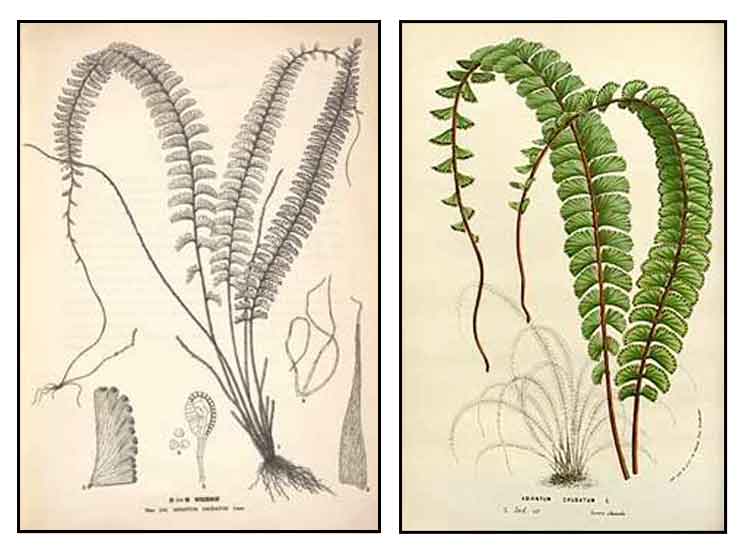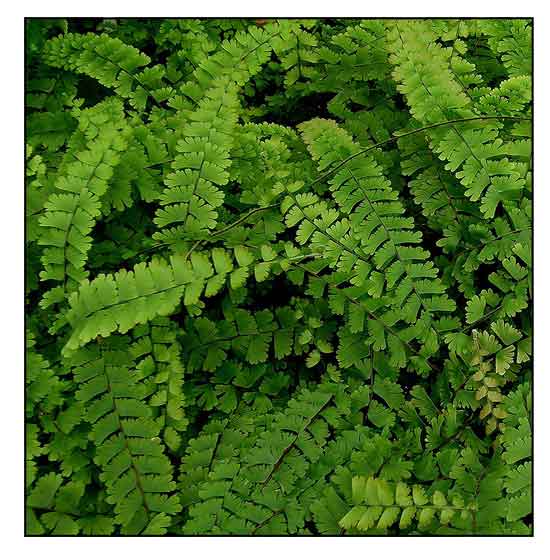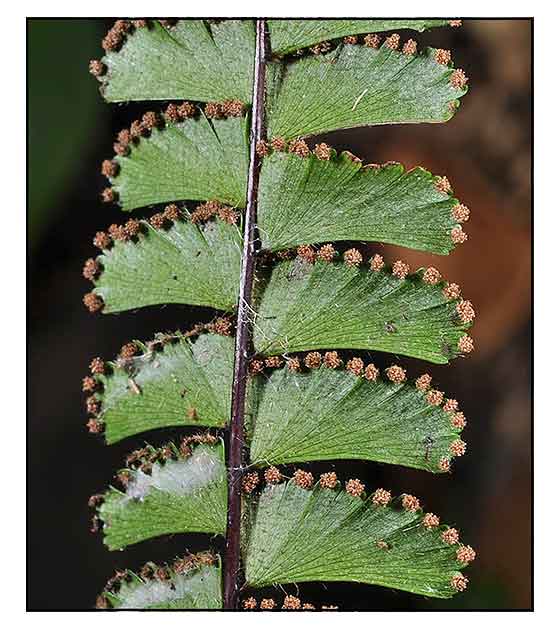 Gen info Gen info
- Adiantum, the maidenhair fern, is a genus of about 250 species of ferns in the subfamily Vittarioidea of the family Pteridaceae. Some researchers place it in its own family, Adiantaceae. (3)
- Etymology: The genus name Adiantum derives from Greek,
meaning "unwetted", referring to the fronds' ability to shed water without becoming wet.
Botany
Alambrillong-gubat is a fern. Stipes are tufted, erect or spreading, more or less covered with brown hairs, 5 to 20 centimeters long. Fronds are linear in outline, simply pinnate, 15 to 30 centimeters long; the leaflets, 1 to 2 centimeters long; the upper margin is rounded, and more or less cut. Rachis and both surfaces of the frond are villose, rooting at the apex; the sori are roundish on the edges of the lobes.
 Adiantum caudatum is a terrestrial or epilithic plant, 10-40 cm tall. Rhizomes erect, short, scales deeply castaneous, lanceolate, margins entire. Fronds clustered; stipe castaneous, 1-10 cm, densely dark brown or brownish multicellular hirsute; lamina 1-pinnate, lanceolate in outline, 15-30 × 2-4 cm, base slightly narrow; rachis same color as stipe and similarly sparsely hirsute, glabrescent when old, apex usually prolonged into a whiplike stolon rooting at tip to form new plantlet; pinnules 20-44 pairs, 5-8 mm apart, alternate, or lower ones subopposite, horizontally spreading or slightly obliquely spreading, lower pinnules gradually reduced, middle ones ± dimidiate, suboblong, 0.7-2 × 0.6-1 cm, papery, brownish green, both surfaces sparsely multicellular hirsute and densely pubescent, base asymmetrical, lower margins substraight and entire, upper and outer margins deeply divided into many narrow lobes, upper side truncate; lobes linear, margins entire, upper part again lobed into fine linear segments, apex truncate, fine segments truncate or few dentate at apex; veins multidichotomously branching, visible on both surfaces. Sori 5-12 per pinna; false indusia dark brown, orbicular or oblong, hairy, upper margins flat and straight, entire, persistent. Perispore granular. (Flora of China) Adiantum caudatum is a terrestrial or epilithic plant, 10-40 cm tall. Rhizomes erect, short, scales deeply castaneous, lanceolate, margins entire. Fronds clustered; stipe castaneous, 1-10 cm, densely dark brown or brownish multicellular hirsute; lamina 1-pinnate, lanceolate in outline, 15-30 × 2-4 cm, base slightly narrow; rachis same color as stipe and similarly sparsely hirsute, glabrescent when old, apex usually prolonged into a whiplike stolon rooting at tip to form new plantlet; pinnules 20-44 pairs, 5-8 mm apart, alternate, or lower ones subopposite, horizontally spreading or slightly obliquely spreading, lower pinnules gradually reduced, middle ones ± dimidiate, suboblong, 0.7-2 × 0.6-1 cm, papery, brownish green, both surfaces sparsely multicellular hirsute and densely pubescent, base asymmetrical, lower margins substraight and entire, upper and outer margins deeply divided into many narrow lobes, upper side truncate; lobes linear, margins entire, upper part again lobed into fine linear segments, apex truncate, fine segments truncate or few dentate at apex; veins multidichotomously branching, visible on both surfaces. Sori 5-12 per pinna; false indusia dark brown, orbicular or oblong, hairy, upper margins flat and straight, entire, persistent. Perispore granular. (Flora of China)
Distribution
- Native to the Philippines.
- Widely distributed in the Philippines, especially common in thickets.
- Also native to Assam, Bangladesh, Borneo, Cambodia, China, Hainan, Himalaya, India, Laos, Lesser Sunda Is., Malaya, Myanmar, Nepal, New Caledonia, New Guinea, Sri Lanka, Sulawesi, Taiwan, Thailand, Vanuatu, Vietnam. (4)
Constituents
- Study of various extracts of leaves showed TPC (total phenolic content) of 27.2 µg (methanolic), 21.2 µg (aqueous), and 16.7 µg (hexanic) of gallic equivalents per mL. TFCs (total flavonoid content) were 13.2 µg (methanolic), 11.6 µg (aqueous), and 10.0 µg (hexanic of rutin equivalents per mL. (see study below) (9)
- Preliminary phytochemical analysis reported 12 different types of secondary metabolites viz. alkaloids, anthocyanin, anthraquinones, cardiac glycosides, coumarin, diterpenes, emodins, flavonoids, saponins, tannins, and terpenoids.
(12)
 Properties Properties
- Considered antispasmodic, antiasthmatic.
- Studies have shown cytotoxic, antidiabetic, hypolipidemic, antioxidant, antimicrobial properties.
Parts used
Leaves, fronds, aerial parts.
Uses
Folkloric
- Leaves are used in the preparation of "sirop-de-capillaire."
- In Bourbon, used to cure coughs and fevers.
- Externally, used as a remedy for skin diseases; internally, said to be useful for diabetes.
- Used to treat jaundice, scabies, constipation, abdominal pain.
- In Ayurveda, leaves used for diabetes.
(7)
- In India, fronds are used as substitute for Adiantum capillus-veneris.
- In Chamoli, India, fronds are used for skin disease, diabetes, cough and fever. (10)
Studies
• Antimicrobial: A study tested four important Adiantum species (A. capillus-veneris, A. peruvianum, A. venustum and A. caudatum) for antimicrobial activity against 5 gram positive, 6 gram negative, and 8 fungal strains. Maximum activity was exhibited by AV followed by ACV, AP and AC. The antimicrobial activity seemed related to the phenolic content. (1)
• Cytotoxicity: Extracts of 16 Bangladeshi plants were screened against human gastric, colon, and breast cancer lines. The methanolic extracts from Adiantum caudatum and B. lacera showed high cytotoxicity against all cell lines tested. (2)
• Anti-Diabetic Potential: Study evaluated the potential inhibitory activity of extracts and fractions of Adiantum caudatum Linn. and Celosia argentea Linn. on α-amylase and α-glucosidase enzymes. Fraction 2 of A. caudatum and fraction 4 of C. argentea showed highest α-amylase and α-glucosidase inhibitory potential. A. caudatum showed an IC50 of 0.241 and 0.211, respectively, comparable to acarbose (0.125 and 0.93 mg/ml). Other extracts and fractions showed lower activity. (5)
• Antibacterial / Fronds: Study evaluated fronds of Adiantum caudatum for antibacterial potential against bacterial species involved in skin diseases in humans. A methanol extract showed maximum level of activity towards Pseudomonas aeruginosa, a resistant strain towards amoxicillin and chloramphenicol. Flavonoid and phenol content in the methanol extract may be one of the reasons for its antibacterial activity. (6)
• Antioxidant / Antibacterial / Leaves: Study evaluated various extract of Adiantum caudatum leaves for phenolic content, flavonoid content, and antioxidant and antimicrobial potential. Antioxidant activities of the extracts in reducing power, FRAP, phosphomolybdate and ABTS assays were methanolic > aqueous > hexanic. In DPPH assay, the aqueous extract showed slightly higher antioxidant activity than the methanolic extract. In antibacterial testing against Bacillus subtilis, E. coli, and Pseudomonas aeruginosa, the aqueous extract was the most potent. (see constituents above) (8)
• Hypoglycemic / Hypolipidemic / Leaves: Study evaluated the hypoglycemic and antihyperlipidemic effect of ethanolic extract of A. caudatum whole plant in alloxan induced diabetic rats. Results showed a significant decrease in blood glucose level and significant decrease in serum total cholesterol and triglycerides. (9)
Availability
- Wild-crafted.
|

![]()






